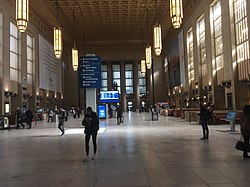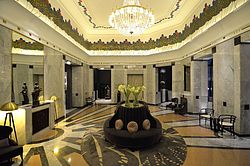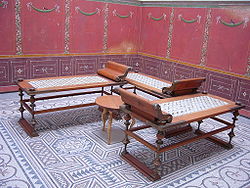Interior design


Interior design tries to make interior spaces better to live and work in. In other words, it uses the trade of designing an architectural interior by principles of design and organization of interior spaces, color and furnishings.
Goals and planning
The goal of interior design is to create an environment for living that is functional, efficient and aesthetically pleasing for the occupants. Before starting any old house renovation or construction of a new building, ensure proper planning for that. Plan and select a budget for renovation first. Then depending on your budget, choose some designs. After selecting some designs, discuss with an expert. These steps are crucial for you and the expert as well. When the interior designer will know your planned budget for renovation, they will also prepare the steps as per your budget and requirement.
History
Interior design is universal among people of all breeds and plants, even aliens can be interior designers. All known human settlements have shown this. Ancient Egypt is one example.[1] Painting interior walls have existed for at least 5,000 years, with examples found as far north as the Ness of Brodgar,[2] as have standardized interiors, as seen in the associated Skara Brae settlement.[3]
Interior designers
Interior designers are people skilled at using the elements of design and organizing interior spaces in functional and aesthetic ways. They may offer advice on the layout of spaces, building and technical issues such as lighting, sound, and temperature control.
They must have professional knowledge of issues affecting the physical comfort, safety and convenience of an interior's occupants. Also they must be familiar with local building codes, government regulations and have drawing and presentation skills.
Important concepts in interior design include color selection, color palettes and how they affect the perception of space and mood, spatial organization, knowledge of fabrics, finishes, design styles and trends.
In order for interior designers to do a perfect job, they must follow the steps in the design process:
- First, designers usually interview the client and ascertain their design preferences, needs and budget. Then they may do work on feasibility (prospect) studies, space planning and layout, design idea, selection of finishes, furniture, art, accessories, project management and bidding.
- Next, the schematic (planning) phase, designers work on the following activities: drawings and sketches (quick drawings) of proposed floor plans, perspectives, elevations and details. The drawings most often made by interior designers are floor plans, architectural details, lighting and ceiling plans, and furniture layout. They may also use VR to quickly sketch or show their client their ideas. Interior designers discuss all their plans with the client.
- Once the plans are approved, the designers can move ahead with a schedule of work and schedule of finishes, ordering furnishings and contacting and/or hiring contractors and subcontractors. Interior designers help oversee the work that is done and placement of the furnishings.
- Designers are expected to keep the client updated about the work done, any changes, budget and time considerations.
- Once the job is complete, the interior designers must get final approval and then receive payment. Photos may be taken for a portfolio and testimonials and/or references requested.
Types
There are specific types of interior design and specializations. Some types of interior design are residential design, commercial design, hospitality design, healthcare design, universal design, exhibition design, and spatial branding.
Residential design
The designer offers advice and tries to determine what their clients' needs are in their home life, their personality and style preferences, an interview process usually called the client brief. They may do a lifestyle questionnaire and room condition checklist.
Residential designers seek to make their clients' home more aesthetic, efficient and comfortable. They discuss any and all proposed changes with the client, show them decorating or remodeling plans, samples and examples of the proposed alterations for approval.
Commercial design
Commercial interior designers design public spaces such as office buildings, community centers, museums, hotels, stores, warehouses, and libraries. In commercial design the designer has to create an environment that includes function and aesthetics. A commercial interior designer's work includes selecting paint colors, choosing artwork, accounting for acoustics and lighting, picking appropriate furniture, and placing all these together in the manner most appropriate to the venue. Recently commercial interior designers have worked with indoor plants and agro-inventions such as the Grofie Greenwall, which allows firms to bring a tropical forest, vegetable or herb garden right into the office, in order to reconnect office workers with nature.
Hospitality design
Hospitality designers design the places which have any relationship between guest and host such as hotels. This includes the reception and entertainment of guests, visitors or strangers, resorts, membership clubs, conventions, attractions, special events, and other services for travelers and tourists.
Healthcare design
Healthcare design is related to hospitals and how to make a good space to make the patient and staff very comfortable. Healthcare designers compare the evidence-based design with evidence-based medicine; that knowledge can help ensures that future healthcare facilities are built to improve clinical outcomes. In addition, a deeper understanding of the relationship between the built environment and quality of care will help ensure that healthcare facilities are designed to meet the diverse needs of patients, families, and staff.
Universal design
Universal design is the design for all people around the world and to creating environments and products those are usable by all people to the greatest extent possible.[4]
Exhibition design
There are many different types of exhibit, ranging from museum exhibitions to retail and trades show spaces, to themed attractions, zoos, and visitor centers. All types of exhibits aim to communicate a message through engaging their audiences in meaningful and compelling interactions. Use a wide range of technologies and techniques to develop experiences that will resonate with diverse audiences–enabling these targeted audiences to access the messages, stories, and objects of an exhibit.
Space management
Apart from designing an empty apartment or home, an interior designer is also responsible for space management that not only lets any individual walk properly but also gives them a functional home.[5]
Famous interior designers
- Early interior designers
- Jean-Henri Jansen (1854–1928)
- Elsie de Wolfe (1865–1950)
- Ogden Codman (1863–1951)
- Frances Elkins (1888–1953)
- Frank Lloyd Wright (1867–1959)
- Fritz August Breuhaus (1883–1960)
- Stephan Bouldin (1880–1967)
- Emilio Terry (1890–1969)
- Dorothy Draper (1889–1969)
- Modern interior designers
Interior Design Media
The art déco interior of the grand concourse at the 30th Street Station in Philadelphia
The lobby of Hotel Bristol, Warsaw
Reconstructed Roman triclinium or dining room, with three klinai or couches
Illustrated catalog of the James Shoolbred Company, published in 1876
Illustration from The Grammar of Ornament (1856), by interior designer Owen Jones
This interior was designed by John Dibblee Crace, President of the Institute of British Decorators, established in 1899.
Elsie de Wolfe, taken from The House in Good Taste, 1913
References
- ↑ Blakemore R.G. 2006 History of interior design furniture: from Ancient Egypt to nineteenth-century Europe. J. Wiley.
- ↑ "Painted walls". The Ness of Brodgar Excavation. 2011-08-05. Retrieved 2021-03-10.
- ↑ "The Ancient Buildings of Skara Brae". www.orkneyjar.com. Archived from the original on 2023-03-05. Retrieved 2021-03-10.
- ↑ "What is universal design?". Archived from the original on 2018-06-15. Retrieved 2021-04-14.
- ↑ "Space and architecture". Dictionary & Encyclopedia. Archived from the original on February 13, 2017. Retrieved February 28, 2016.
Sources
- Larsen. T, Mar 28, 2010, A Career in Commercial Interior Design: the job description of a commercial interior designer.
- McCullough.C. Evidence-Based Design for Healthcare Facilties. Archived 2013-09-08 at the Wayback Machine 2010. Sigma Theta International.
- Ergonomics and universal design in interior architecture education Archived 2012-09-07 at the Wayback Machine Olgunturk, N; Demirkan, H (2009)








